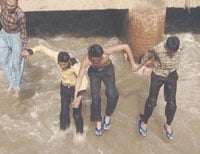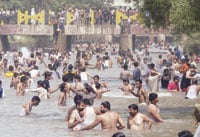Originally published in The Friday Times.
The destruction of Lahore’s environment is a trend that needs to be reversed, says Raza Rumi:
Moaning about Lahore’s most elitist enclave, GOR-I, is a contentious undertaking. On the one hand, it was, until recently, the best of what the British left us – lovingly adorned with diverse species of trees, home to glorious specimens of ecologically-friendly architecture and an old-world-charm unparalleled for its simplicity and elegance. On the other hand, it was also a symbol of the extractive, Punjab-centric colonial state of the nineteenth century, lorded over by the agents of the Indian civil service.
But when one has lived in those sublime environs, not as the scion of a landed, aristocratic clan but rather as a member of a middle-class, professional family, what is one to do? GOR-I was a lonely plant of sorts amid the sprawl of Lahore, with trees, birds and orchards one would not have expected to find in an Asian mega-city. In the spring, we strolled amid the just-bloomed shrubs; in the summer, amaltas trees and shady, mythical jamuns greeted us at every corner. In winter, GOR-I was a misty, freezing locale, reminiscent of the little hill-stations nurtured by the British while they controlled the destiny of India.
We would often step out of the little lanes of GOR-I and walk all the way to Ferozsons bookshop on the Mall to browse through the new titles. This was an age when video games had not captured the energies of the young, when the internet had not even been dreamt of, and when the television, in those dark years of General Zia-ul-Haq, was a daily booster shot of boredom. This is not the case anymore, for by now one has already mourned the loss of Lahore to rampant and senseless greed, the vagaries of the land mafia and the absolute failure of the civic authorities. It is inconceivable now to walk anywhere along the Mall without inhaling toxic fumes, or worse, being hit by a speeding vehicle. Decay is all around us. Its foremost manifestation can be seen in the way the Lahori elites and residents have slowly poisoned their city.
Much could be said on the suicidal tendencies of the natives in general, for it is not with Lahore alone that we are concerned. Suicide is evident all over the place. From a young, brainwashed lad who blows himself up in search of paradise to a state that is its own worst enemy, our irrational behavior is simply mind-boggling. One had learned from dear Darwin that evolution was about the survival of the fittest. But the global destruction of the environment, now evident in the process of climate change, testifies to how humans have failed to grasp the instinct of self-preservation.
It is absolutely unacceptable that Lahore is the most polluted city of Pakistan. New data with particulate matter assessments reveal that Lahore takes the cake when it comes to air pollution and the attendant dangers to public health. Science tells us that particulate matter of ‘2.5’ variety is lethal, for it is extremely fine; when inhaled, it settles below the lungs and enters the bloodstream. Public health officials say that this can reduce the lungs’ functions and even cause blood-clotting. In Lahore, the recent average count recorded for particulate matter was 122 micrograms per cubic metre, against a safety threshold of 35 micrograms! Lahore’s count is the highest of the country’s five major cities – Peshawar is at 79.1, Quetta at 47 and Islamabad, despite its small population, is at 75. Karachi is doing slightly better than both Islamabad and Lahore, with an average of 53 micrograms per cubic metre.
But does one even really need this data? The problem is self-evident. When standing on a corner of the Mall Road, in a nook of the old Lahore or a cranny of Ferozepur Road, it is amply clear that the level of pollution is intolerable. As children, we entered Lahore and were awed by the wondrous domes of the Badshahi mosque; now, coming in on the GT Road, all we see is smoke. This year’s heat wave, preceded by an unusually warm winter, makes it undeniable that climate change is not only real but is striking close to home; it can no longer be passed off as the outcry of dreamy, Fabian environmentalists.
What else could we have expected, given that there is not a cogent or even half-decent urban plan in sight for Lahore? Let alone a plan, there is not even a proper urban policy; all we have is mayhem and policy chaos. The agencies responsible for city planning and administration are under-funded and negligent. Much is made of our wide boulevards and well-paved roads, but there is no public transport in Lahore. This is the next thing to criminal, as the total car-owning population may be small, but it is still lethal with 1.8 million registered vehicles on the road – the catalyst of Lahore’s environmental holocaust. Whatever ‘public transport’ we have – almost all of it private business – is owned by the transport mafia, which in collusion with the City Police, the Road Transport Authority and other dysfunctional agencies, is more than happy to keep smoke-emitting vehicles on the roads.
Over 20,000 rickshaws roam the streets of Lahore, worsening air pollution levels. The rickshaws are unaffordable for the general public, in whose name the constitutions are framed and twisted, who are the fodder and imagined beneficiaries of democracy and for whom billions pour into Pakistan from international donors – to improve their lot.
There was a little scheme of green, four-stroke rickshaws that operate on CNG, but the transition has been slow and is now trapped in the bureaucratic maze. The new CNG buses are a welcome development, but they are too few and have been launched in a policy vacuum. Until a transport policy with a five- to ten-year horizon is developed, we cannot expect much real success. After all, the other innovations that were launched, such as public-private partnerships for urban transport, were killed by none other than the judiciary. The mafias win everywhere in Pakistan; the transport mafia in particular is very well connected with the centres of power.
What can one hope to do in these circumstances? The state itself is the key to our national and local conundrums. It has already effaced the Indus and Indo-Muslim cultures; now it is attempting, even if by negligence, to do the same to the environment. Who will regulate public goods and entitlements, if not the state?
There have been some hints of a silver lining. The Lahore bachao tehreek, for example, played an active role in preserving trees and saving some green spaces of Lahore. Its activism led to some measure of protection, but at the end of the day, the Canal has still suffered tree-felling for access to the homes and offices of political elites, while administrators take pride in completing the underpasses in record time. Have such measures even helped with the decongestion of traffic? Of course not: stopgap measures are no alternative to cohesive planning in the public interest. Any visitor to Bangkok, on the other hand, can see that despite the huge vehicular population, civic planners have managed to bring down the levels of air pollution. Tackling such issues is not impossible, despite what naysayers in the media and bureaucracy would have us believe.
We do not even have a proper discourse on the environment here. In the mainstream media or academia, the environment rarely finds a slot. Legislators address it only infrequently. Judicial activism, on a limited scale, was witnessed in the past – it managed a few successes, but there are still far too many ‘notices’ and not enough action. Issues like the environment are looked down upon as a concern of the Westernized elites, whom the Pakistani textbook nationalists think should be annihilated anyway to fulfill the jihad agenda drawn up, ironically, by the secular civil-military bureaucracies.
Things in Pakistan are dire. We face the spectre of glacial melt – partly accelerated by the Siachen War – our forest cover has eroded as fast as our values, and our rivers are drying up, when pollution does not destroy them first from the inside. We need policies to help us deal with climate change – attempts to both mitigate it and adapt to it; we need emergency work on our forests, our rivers and our agricultural practices. Without this, we have no hope for survival on this endangered planet.
Why not begin with Lahore? Why not commence with sensible urban planning and transport strategies for Pakistan’s cultural capital, its political nerve-centre? Why not use Lahore to demonstrate to others that this can be done?
I want my trees back. My Lahore must not be destroyed any further.




